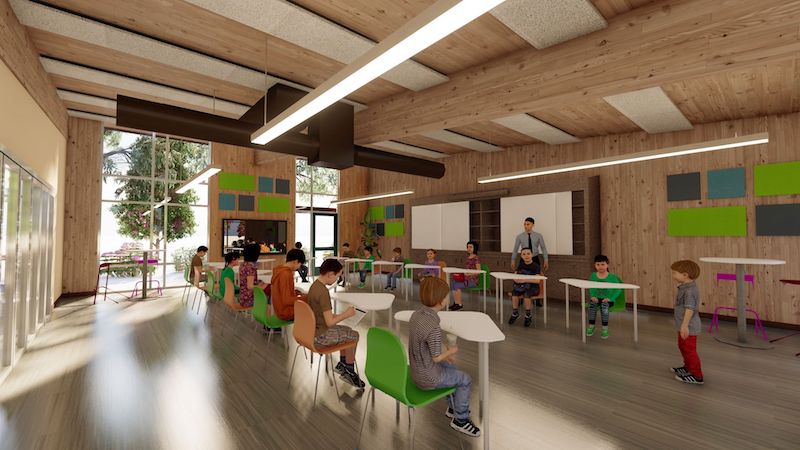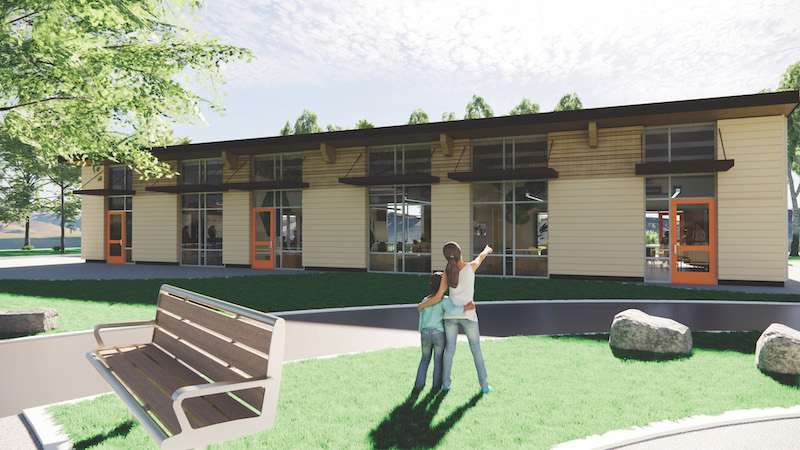The website expertmarketresearch.com estimates that the value of the global cross-laminated timber market hit $779 million in 2020, and is expected to grow annually by 13% to $1.624 billion in 2026.
As demand for mass timber increases, branding is beginning to emerge. One example is TimberQuest, an advanced prefabricated school construction product for the California educational market, which was recently launched by three Bay Area AEC firms: Milpitas-based XL Construction, San Jose-based Aedis Architects, and Saratoga-based Daedalus Structural Engineering.
The trio’s first project using its product is a new 4,000-sf building for kindergarten students with four 1,000-sf classrooms, each with its own restroom, for Sacred Heart Schools in Atherton, Calif., whose 63-acre campus and K-12 curriculum serve more than 800 families. The school greenlighted this project—which is believed to be the first of its kind in the nation—on April 1, and the mass timber components were fabricated and delivered to the construction site by June 1. The building team is targeting an August 31 completion date, in time for the fall semester.
“Two of the things we liked most about the TimberQuest classroom design is the ‘daylighting’ created by the structure’s large windows combined with the exposed wood interior that makes the classroom very pleasant and appealing,” says Michael Dwyer, Sacred Heart Schools’ director of operations. “The building’s overall energy efficiency supports our sustainability philosophy and stands as a shining example of these values we teach to our students.”
Also see: A fly-through video rendering of a TimberQuest classroom
A FLEXIBLE PRODUCTION APPROACH TO MASS TIMBER CONSTRUCTION

TimberQuest buildings are available in three-to-nine classroom sizes, and are designed to let in lots of natural light.
Matt Larson, XL Construction’s preconstruction director, tells BD+C that his firm and Aedis had worked together previously. “We also knew that we needed a structural expert on both mass timber and California codes. Daedalus [has] local expertise, and has partnered with Fast + Epp, a leading expert on mass timber, to provide both expertise under one roof. XL, Aedis and Daedalus have a core commitment to sustainability and innovation, which are at the heart of TimberQuest.”
Larson went on to explain TimberQuest’s approach to fabrication. For higher-tech items that require expensive machining (such as the mass timber components, the HVAC system, and the glazing system), the building team partners with local suppliers with existing plants. For lower-tech parts of panel fabrication, “there is no requirement for a large plant or expensive tooling,” says Larson. To fabricate walls and roofs, flexible approaches can include “popup” factories in temporary facilities, and using XL’s shop/yard. Fabricating onsite is also an option.
“We feel that this approach will help us avoid a common failure point for this type of venture, namely the overinvestment in facilities and tooling and lack of ability to quickly scale up or down,” says Larson.
FEWER DESIGN DAYS AND ONSITE TRADES
Several factors contribute to TimberQuest’s production speed. These include pre-made design for manufacturing and assembly, and the reduction in the number of trades needed for a project. Larson says that the building team has winnowed the design process—normally 6-12 months—to 6-8 weeks; and has cut the number of trades onsite—typically between 20 and 30—to around 10. “And we hope to reduce it further in the future,” he says.
TimberQuest buildings are available in three- to nine-classroom sizes, between 3,000 and 9,000 sf. A total of nine interior layouts are included in the precheck design, including standard classroom, large classroom, breakout space, office/conference, science, kindergarten and three restroom configurations. The all-electric design utilizes heat pump technology to exceed California’s Title 24 energy usage standards by between 35% and 60%. TimberQuest buildings seek to take full advantage of renewable energy resources.
Related Stories
| May 18, 2011
8 Tips for Designing Wood Trusses
Successful metal-plate-connected wood truss projects require careful attention to detail from Building Team members.
| Jan 21, 2011
Sustainable history center exhibits Fort Ticonderoga’s storied past
Fort Ticonderoga, in Ticonderoga, N.Y., along Lake Champlain, dates to 1755 and was the site of battles in the French and Indian War and the American Revolution. The new $20.8 million, 15,000-sf Deborah Clarke Mars Education Center pays homage to the French magasin du Roi (the King’s warehouse) at the fort.
| Jan 21, 2011
Music festival’s new home showcases scenic setting
Epstein Joslin Architects, Cambridge, Mass., designed the Shalin Liu Performance Center in Rockport, Mass., to showcase the Rockport Chamber Music Festival, as well at the site’s ocean views.
| Dec 17, 2010
5 Tips on Building with SIPs
Structural insulated panels are gaining the attention of Building Teams interested in achieving high-performance building envelopes in commercial, industrial, and institutional projects.
| Dec 7, 2010
USGBC: Wood-certification benchmarks fail to pass
The proposed Forest Certification Benchmark to determine when wood-certification groups would have their certification qualify for points in the LEED rating systemdid not pass the USGBC member ballot. As a result, the Certified Wood credit in LEED will remain as it is currently written. To date, only wood certified by the Forest Stewardship Council qualifies for a point in the LEED, while other organizations, such as the Sustainable Forestry Initiative, the Canadian Standards Association, and the American Tree Farm System, are excluded.
| Nov 3, 2010
Sailing center sets course for energy efficiency, sustainability
The Milwaukee (Wis.) Community Sailing Center’s new facility on Lake Michigan counts a geothermal heating and cooling system among its sustainable features. The facility was designed for the nonprofit instructional sailing organization with energy efficiency and low operating costs in mind.
| Nov 3, 2010
Dining center cooks up LEED Platinum rating
Students at Bowling Green State University in Ohio will be eating in a new LEED Platinum multiuse dining center next fall. The 30,000-sf McDonald Dining Center will have a 700-seat main dining room, a quick-service restaurant, retail space, and multiple areas for students to gather inside and out, including a fire pit and several patios—one of them on the rooftop.
| Nov 2, 2010
Cypress Siding Helps Nature Center Look its Part
The Trinity River Audubon Center, which sits within a 6,000-acre forest just outside Dallas, utilizes sustainable materials that help the $12.5 million nature center fit its wooded setting and put it on a path to earning LEED Gold.
| Oct 12, 2010
Gartner Auditorium, Cleveland Museum of Art
27th Annual Reconstruction Awards—Silver Award. Gartner Auditorium was originally designed by Marcel Breuer and completed, in 1971, as part of his Education Wing at the Cleveland Museum of Art. Despite that lofty provenance, the Gartner was never a perfect music venue.
| Aug 11, 2010
SFI releases new sustainable forestry standard
The Sustainable Forestry Initiative has released a new standard. SFI 2010-2014 addresses climate change and bioenergy; strengthen unique SFI fiber sourcing requirements, which broaden the practice of sustainable forestry; complements SFI activities aimed at avoiding controversial or illegal offshore fiber sources, and embraces Lacey Act amendments to prevent illegal logging; and expands requirements for logger training and support for trained loggers and certified logger programs.














